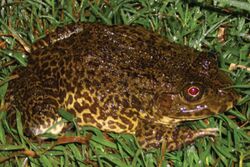Biology:Chinese edible frog
| Chinese edible frog | |
|---|---|

| |
| Scientific classification | |
| Domain: | Eukaryota |
| Kingdom: | Animalia |
| Phylum: | Chordata |
| Class: | Amphibia |
| Order: | Anura |
| Family: | Dicroglossidae |
| Genus: | Hoplobatrachus |
| Species: | H. rugulosus
|
| Binomial name | |
| Hoplobatrachus rugulosus (Wiegmann, 1834)
| |
| Synonyms | |
|
Rana tigrina ssp. pantherina Steindachner, 1867 | |
The Chinese edible frog, East Asian bullfrog, or Taiwanese frog (Hoplobatrachus rugulosus) is a species of frog in the family Dicroglossidae. It is found in Cambodia, China , Hong Kong, Laos, Macau, Malaysia, Myanmar, the Philippines , Taiwan, Thailand, and Vietnam. Its natural habitats are freshwater marshes, intermittent freshwater marshes, arable land, pasture land, rural gardens, urban areas, ponds, aquaculture ponds, open excavations, irrigated land, seasonally flooded agricultural land, and canals and ditches.[1] They breed in spring to early summer.[2]
The domesticated Thai variety and wild Chinese populations of H. rugulosus belong to two separate genetic lineages respectively.[3] Yu et al. (2015) suggest that H. rugulosus may in fact be a cryptic species complex.[3]
Description
H. rugulosus is a large, robust frog, up to 12 centimetres (4 1⁄2 inches) or more in snout-vent length.[2] Females are larger than males. They are primarily insectivores.[4]
Regional names
The Chinese edible frog is commonly referred to as 田雞 ("field chicken") or 虎皮蛙 ("tiger-skinned frog") in Mainland China, Hong Kong, Taiwan, Macau, and Chinese communities worldwide. In Filipino, they are called "palakang bukid," which means "frog of the field."
In Thailand, this species of frog known as "kob na", literally translated as "paddy field frog".
Usage
The frogs are commonly found in wet markets, seafood markets, and pet stores. In wet markets, they are usually sold per piece or per kilogram. The medium-sized frogs are sold as pets in pet stores, and the smaller variant is sold as live food for arowanas. They are widely farmed in Sichuan, China, Malaysia, and Thailand.
These frogs, though much smaller than their Western counterparts, are used by Chinese to cook frog legs and by Filipinos who cook them for adobo dishes. The frog's forelimbs and hind legs are fried in oil, while in the adobo method (in which the entire frog is utilized), they are cooked in soy sauce and vinegar.
References
- ↑ 1.0 1.1 Arvin Diesmos, Peter Paul van Dijk, Robert Inger, Djoko Iskandar, Michael Wai Neng Lau, Zhao Ermi, Lu Shunqing, Geng Baorong, Lue Kuangyang, Yuan Zhigang, Gu Huiqing, Shi Haitao, Chou Wenhao (2004). "Hoplobatrachus rugulosus". IUCN Red List of Threatened Species 2004: e.T58300A11760194. doi:10.2305/IUCN.UK.2004.RLTS.T58300A11760194.en. https://www.iucnredlist.org/species/58300/11760194. Retrieved 17 November 2021.
- ↑ 2.0 2.1 Lue, Kuang-Yang. "Hoplobatrachus rugulosus". BiotaTaiwanica. http://amphibia.biota.biodiv.tw/pages/394. Retrieved 13 December 2012.
- ↑ 3.0 3.1 Yu D, Zhang J, Li P, Zheng R, Shao C (2015) Do Cryptic Species Exist in Hoplobatrachus rugulosus? An Examination Using Four Nuclear Genes, the Cyt b Gene and the Complete MT Genome. PLoS ONE 10(4): e0124825. doi:10.1371/journal.pone.0124825
- ↑ Lin, Z.; Ji, X. (2005). "Sexual dimorphism in morphological traits and food habits in tiger frogs, Hoplobatrachus rugulosus in Lishui, Zhejiang". Zoological Research 26 (3): 255–262. https://tspace.library.utoronto.ca/bitstream/1807/9310/1/zr05006.pdf.
Wikidata ☰ Q711322 entry
 |


